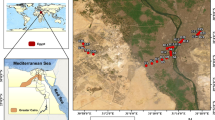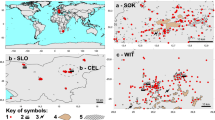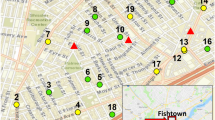Abstract
Road dust is an indicator widely used when monitoring contamination and evaluating environmental and health risks in urban ecosystems. We conducted an exhaustive characterization of road dust samples coupling their chemical characteristics and stable isotope compositions (C and N) with the aim of evaluating the levels and spatial distribution of local contamination as well as to identify its main source(s) in the coastal city of Cienfuegos (Cuba). Results indicate that the concentrations of several elements (total nitrogen, S, Ca, V, Cu, Zn, Mo, Sn, Hg, and Pb) exceed the background values reported for both Cuban soils and the upper continental crust (UCC) and showed a high variability among the sampling sites. We show that road dust contamination in Cienfuegos induces high associated ecological risks. Among the studied elements, Cd and Hg are the major contributors to the environmental contamination in the city, mainly along busy roads and downtown. δ13C and δ15N, coupled to a multivariate statistical analysis, help associate the studied elements to several local sources of contamination: mineral matter derived from local soils, cement plant and related activities, road pavement alteration, power plant, road traffic, and resuspension of particulate organic matter (POM). Our results suggest that incorporating the chemical and isotope monitoring of road dust may help implement more effective environmental management measures in order to reduce their adverse impact on ecosystems and human health.





Similar content being viewed by others
References
Abbasi S, Keshavarzi B, Moore F, Delshab H, Soltani N, Sorooshian A (2017) Investigation of microrubbers, microplastics and heavy metals in street dust: a study in Bushehr city, Iran. Environ Earth Sci 76:798–719. https://doi.org/10.1007/s12665-017-7137-0
Abbasi S, Keshavarzi B, Moore F, Mahmoudi MR (2018) Fractionation, source identification and risk assessment of potentially toxic elements in street dust of the most important center for petrochemical products, Asaluyeh County, Iran. Environ Earth Sci 77:673–619. https://doi.org/10.1007/s12665-018-7854-z
Adachi K, Tainosho Y (2004) Characterization of heavy metal particles embedded in tire dust. Environment International 30:1009–1017. https://doi.org/10.1016/j.envint.2004.04.004
Adamiec E, Jarosz-Krzemińska E, Wieszała R (2016) Heavy metals from non-exhaust vehicle emissions in urban and motorway road dusts. Environmental Monitoring and Assessment 188:369. https://doi.org/10.1007/s10661-016-5377-1
Alfaro MR, Montero A, Ugarte OM, do Nascimento CW, de Aguiar Accioly AM, Biondi CM, da Silva YJ (2015) Background concentrations and reference values for heavy metals in soils of Cuba. Environ Monit Assess 187:4198. https://doi.org/10.1007/s10661-014-4198-3
Alfaro MR, do Nascimento CWA, Biondi CM et al (2018) Rare-earth-element geochemistry in soils developed in different geological settings of Cuba. CATENA 162:317–324. https://doi.org/10.1016/j.catena.2017.10.031
Alonso-Hernandez CM, Bernal-Castillo J, Bolanos-Alvarez Y et al (2011) Heavy metal content of bottom ashes from a fuel oil power plant and oil refinery in Cuba. Fuel 90:2820–2823. https://doi.org/10.1016/j.fuel.2011.03.014
Alonso-Hernández CM, Garcia-Moya A, Tolosa I et al (2017) Tracing organic matter sources in a tropical lagoon of the Caribbean Sea. Cont Shelf Res 148:53–63. https://doi.org/10.1016/j.csr.2017.08.001
Alves CA, Evtyugina M, Vicente AMP, Vicente ED, Nunes TV, Silva PMA, Duarte MAC, Pio CA, Amato F, Querol X (2018) Chemical profiling of PM 10 from urban road dust. Sci Total Environ 634:41–51. https://doi.org/10.1016/j.scitotenv.2018.03.338
Amiri H, Zare M, Widory D (2015) Assessing sources of nitrate contamination in the Shiraz urban aquifer (Iran) using the δ15N and δ18O dual-isotope approach. Isotopes Environ Health Stud 51:392–410. https://doi.org/10.1080/10256016.2015.1032960
Andrews JE, Greenaway AM, Dennis PF (1998) Combined carbon isotope and C/N ratios as indicators of source and fate of organic matter in a poorly flushed, tropical estuary: Hunts Bay, Kingston Harbour, Jamaica. Estuar Coast Shelf Sci 46:743–756. https://doi.org/10.1006/ecss.1997.0305
Asar Ö, Ilk Ö, Dag O (2017) Estimating Box-Cox power transformation parameter via goodness-of-fit tests. Commun Stat Simul Comput 46:91–105. https://doi.org/10.1080/03610918.2014.957839
Bandowe BAM, Nkansah MA, Leimer S, Fischer D, Lammel G, Han Y (2018) Chemical (C, N, S, black carbon, soot and char) and stable carbon isotope composition of street dusts from a major West African metropolis: implications for source apportionment and exposure. Sci Total Environ 655:1468–1478. https://doi.org/10.1016/j.scitotenv.2018.11.089
Bourliva A, Christophoridis C, Papadopoulou L, Giouri K, Papadopoulos A, Mitsika E, Fytianos K (2017) Characterization, heavy metal content and health risk assessment of urban road dusts from the historic center of the city of Thessaloniki, Greece. Environ Geochem Health 39:611–634. https://doi.org/10.1007/s10653-016-9836-y
Bourliva A, Kantiranis N, Papadopoulou L et al (2018) Seasonal and spatial variations of magnetic susceptibility and potentially toxic elements (PTEs) in road dusts of Thessaloniki city, Greece: a one-year monitoring period. Sci Total Environ 639:417–427. https://doi.org/10.1016/j.scitotenv.2018.05.170
Celo V, Dabek-Zlotorzynska E, Zhao J, Bowman D (2012) Concentration and source origin of lanthanoids in the Canadian atmospheric particulate matter: a case study. Atmos Pollut Res 3:270–278. https://doi.org/10.5094/APR.2012.030
Christoforidis A, Stamatis N (2009) Heavy metal contamination in street dust and roadside soil along the major national road in Kavala’s region, Greece. Geoderma 151:257–263. https://doi.org/10.1016/j.geoderma.2009.04.016
Cuellar-Martinez T, Ruiz-Fernández AC, Alonso-Hernández C et al (2018) Addressing the problem of harmful algal blooms in Latin America and the Caribbean- a regional network for early warning and response. Front Mar Sci 5. https://doi.org/10.3389/fmars.2018.00409
Das A, Krishna KVSS, Kumar R, Saha MC, Sengupta S, Ghosh JG (2017) Lead isotopic ratios in source apportionment of heavy metals in the street dust of Kolkata, India. Int J Environ Sci Technol 15:1–14. https://doi.org/10.1007/s13762-017-1377-0
Dehghani S, Moore F, Keshavarzi B, Hale BA (2017) Health risk implications of potentially toxic metals in street dust and surface soil of Tehran, Iran. Ecotox Environ Safe 136:92–103. https://doi.org/10.1016/j.ecoenv.2016.10.037
Díaz Rizo O, Rivero Plama O, D’Alessandro Rodríguez K, García Trápaga C (2015) Distribución espacial y estudio de contaminación por metales pesados en polvos urbanos de la ciudad de Camagüey (Cuba) mediante fluorescencia de rayos X. Nucleus 58:34–38
Fattorini D, Alonso-Hernandez CM, Diaz-Asencio M, Munoz-Caravaca A, Pannacciulli FG, Tangherlini M, Regoli F (2004) Chemical speciation of arsenic in different marine organisms: importance in monitoring studies. Marine Environmental Research 58:845–850. https://doi.org/10.1016/j.marenvres.2004.03.103
Ferreira-Baptista L, De Miguel E (2005) Geochemistry and risk assessment of street dust in Luanda, Angola: a tropical urban environment. Atmos Environ 39:4501–4512. https://doi.org/10.1016/j.atmosenv.2005.03.026
Ghanavati N, Nazarpour A, Watts MJ (2019) Status, source, ecological and health risk assessment of toxic metals and polycyclic aromatic hydrocarbons (PAHs) in street dust of Abadan, Iran. CATENA 177:246–259. https://doi.org/10.1016/j.catena.2019.02.022
Grigoratos T, Martini G (2015) Brake wear particle emissions: a review. Environmental Science and Pollution Research 22:2491–2504. https://doi.org/10.1007/s11356-014-3696-8
Hakanson L (1980) An ecological risk index for aquatic pollution control. A sedimentological approach. Water Res 14:975–1001. https://doi.org/10.1016/0043-1354(80)90143-8
Johansson C, Norman M, Burman L (2009) Road traffic emission factors for heavy metals. Atmos Environ 43:4681–4688. https://doi.org/10.1016/j.atmosenv.2008.10.024
Kawashima H, Haneishi Y (2012) Effects of combustion emissions from the Eurasian continent in winter on seasonal δ13C of elemental carbon in aerosols in Japan. Atmos Environ 46:568–579. https://doi.org/10.1016/j.atmosenv.2011.05.015
Keshavarzi B, Abbasi S, Moore F, Mehravar S, Sorooshian A, Soltani N, Najmeddin A (2018) Contamination level, source identification and risk assessment of potentially toxic elements (PTEs) and polycyclic aromatic hydrocarbons (PAHs) in street dust of an important commercial center in Iran. Environ Manage 62:803–818. https://doi.org/10.1007/s00267-018-1079-5
Kojima K, Murakami M, Yoshimizu C, Tayasu I, Nagata T, Furumai H (2011) Evaluation of surface runoff and road dust as sources of nitrogen using nitrate isotopic composition. Chemosphere 84:1716–1722. https://doi.org/10.1016/j.chemosphere.2011.04.071
Kojima K, Sano S, Kurisu F, Furumai H (2017) Estimation of source contribution to nitrate loading in road runoff using stable isotope analysis. Urban Water J 14:337–342. https://doi.org/10.1080/1573062X.2016.1148176
Kump LR, Arthur MA (1999) Interpreting carbon-isotope excursions: carbonates and organic matter. Chem Geol 161:181–198. https://doi.org/10.1016/S0009-2541(99)00086-8
Kupiainen KJ, Tervahattu H, Räisänen M, Mäkelä T, Aurela M, Hillamo R (2005) Size and composition of airborne particles from pavement wear, tires, and traction sanding. Environ Sci Technol 39:699–706. https://doi.org/10.1021/es035419e
Lanzerstorfer C (2018) Heavy metals in the finest size fractions of road-deposited sediments. Environ Pollut 239:522–531. https://doi.org/10.1016/j.envpol.2018.04.063
LeGalley E, Widom E, Krekeler MPS, Kuentz DC (2013) Chemical and lead isotope constraints on sources of metal pollution in street sediment and lichens in southwest Ohio. Appl Geochem 32:195–203. https://doi.org/10.1016/j.apgeochem.2012.10.020
Li Z, Feng X, Li G et al (2013) Distributions, sources and pollution status of 17 trace metal/metalloids in the street dust of a heavily industrialized city of central China. Environ Pollut 182:408–416. https://doi.org/10.1016/j.envpol.2013.07.041
Li Y, Yu Y, Yang Z, Shen Z, Wang X, Cai Y (2016) A comparison of metal distribution in surface dust and soil among super city, town, and rural area. Environ Sci Pollut Res 23:7849–7860. https://doi.org/10.1007/s11356-015-5911-7
Li F, Jinxu Y, Shao L et al (2018a) Delineating the origin of Pb and Cd in the urban dust through elemental and stable isotopic ratio: a study from Hangzhou City, China. Chemosphere 211:674–683. https://doi.org/10.1016/j.chemosphere.2018.07.199
Li X, Zhang M, Gao Y et al (2018b) Urban street dust bound 24 potentially toxic metal/metalloids (PTMs) from Xining valley-city, NW China: spatial occurrences, sources and health risks. Ecotox Environ Safe 162:474–487. https://doi.org/10.1016/j.ecoenv.2018.07.006
Li X, Liu B, Zhang Y et al (2019) Spatial distributions, sources, potential risks of multi-trace metal/metalloids in street dusts from Barbican Downtown embracing by Xi’an Ancient City Wall (NW, China). Int J Environ Res Public Health 16:2992. https://doi.org/10.3390/ijerph16162992
Lloyd LN, Fitch GM, Singh TS, Smith JA (2019) Characterization of environmental pollutants in sediment collected during street sweeping operations to evaluate its potential for reuse. J Environ Eng-ASCE 145:04018141. https://doi.org/10.1061/(ASCE)EE.1943-7870.0001493
Lopez-Veneroni D (2009) The stable carbon isotope composition of PM2.5 and PM10 in Mexico City Metropolitan Area air. Atmos Environ 43:4491–4502. https://doi.org/10.1016/j.atmosenv.2009.06.036
Manno E, Varrica D, Dongarra G (2006) Metal distribution in road dust samples collected in an urban area close to a petrochemical plant at Gela, Sicily. Atmos Environ 40:5929–5941. https://doi.org/10.1016/j.atmosenv.2006.05.020
Manuel Trujillo-Gonzalez J, Aurelio Torres-Mora M, Keesstra S et al (2016) Heavy metal accumulation related to population density in road dust samples taken from urban sites under different land uses. Sci Total Environ 553:636–642. https://doi.org/10.1016/j.scitotenv.2016.02.101
Mari M, Sanchez-Soberon F, Audi-Miro C et al (2016) Source apportionment of inorganic and organic PM in the ambient air around a cement plant: assessment of complementary tools. Aerosol Air Qual Res 16:3230–3242. https://doi.org/10.4209/aaqr.2016.06.0276
Men C, Liu R, Wang Q, Guo L, Shen Z (2018) The impact of seasonal varied human activity on characteristics and sources of heavy metals in metropolitan road dusts. Sci Total Environ 637:844–854. https://doi.org/10.1016/j.scitotenv.2018.05.059
Modabberi S, Tashakor M, Soltani NS, Hursthouse AS (2018) Potentially toxic elements in urban soils: source apportionment and contamination assessment. Environ Monit Assess 190:715–718. https://doi.org/10.1007/s10661-018-7066-8
Moreira González A, Abilio Comas A, Valle Pombrol A, Seisdedo M (2016) Bloom of Vulcanodinium rugosum linked to skin lesions in Cienfuegos Bay, Cuba. HARMFUL ALGAE NEWS 55
Moreno T, Querol X, Alastuey A, Gibbons W (2008) Identification of FCC refinery atmospheric pollution events using lanthanoid- and vanadium-bearing aerosols. Atmos Environ 42:7851–7861. https://doi.org/10.1016/j.atmosenv.2008.07.013
Moreno T, Querol X, Alastuey A et al (2010) Variations in vanadium, nickel and lanthanoid element concentrations in urban air. Sci Total Environ 408:4569–4579. https://doi.org/10.1016/j.scitotenv.2010.06.016
Morera-Gómez Y, Elustondo D, Lasheras E et al (2018a) Chemical characterization of PM10 samples collected simultaneously at a rural and an urban site in the Caribbean coast: local and long-range source apportionment. Atmos Environ 192:182–192. https://doi.org/10.1016/j.atmosenv.2018.08.058
Morera-Gómez Y, Santamaría JM, Elustondo D, Alonso-Hernández CM, Widory D (2018b) Carbon and nitrogen isotopes unravels sources of aerosol contamination at Caribbean rural and urban coastal sites. Sci Total Environ 642:723–732. https://doi.org/10.1016/j.scitotenv.2018.06.106
Morera-Gómez Y, Santamaría JM, Elustondo D et al (2019) Determination and source apportionment of major and trace elements in atmospheric bulk deposition in a Caribbean rural area. Atmos Environment 202:93–104. https://doi.org/10.1016/j.atmosenv.2019.01.019
Pateraki St, Manousakas M, Bairachtari K et al (2019) The traffic signature on the vertical PM profile: environmental and health risks within an urban roadside environment. Sci Total Environ 646:448–459. https://doi.org/10.1016/j.scitotenv.2018.07.28
Rasmussen PE, Subramanian KS, Jessiman BJ (2001) A multi-element profile of house dust in relation to exterior dust and soils in the city of Ottawa, Canada. Sci Total Environ 267:125–140. https://doi.org/10.1016/S0048-9697(00)00775-0
Rudnick RL, Gao S (2014) Composition of the continental crust. In: Holland HD, Turekian KK (eds) Treatise on Geochemistry, Second edn. Elsevier, Oxford, pp 1–51
Seisdedo M, Herrera RH, Arencibia G, Sorinas L (2016) Tools for managing water quality from trophic state in the estuarine system Cienfuegos bay (Cuba). Pan-Am J Aquat Sci 11:264–275
Seisdedo M, Castellanos González ME, Arencibia Carballo G et al (2019) Water quality management in Cienfuegos Bay (Cuba) with integrative approaches. Int J Environ Agric Biotechnol 4:182–186. https://doi.org/10.22161/ijeab/4.1.28
Shi D, Lu X (2018) Accumulation degree and source apportionment of trace metals in smaller than 63 mu m road dust from the areas with different land uses: a case study of Xi’an, China. Sci Total Environ 636:1211–1218. https://doi.org/10.1016/j.scitotenv.2018.04.385
Skrbic BD, Buljovcic M, Jovanovic G, Antic I (2018) Seasonal, spatial variations and risk assessment of heavy elements in street dust from Novi Sad, Serbia. Chemosphere 205:452–462. https://doi.org/10.1016/j.chemosphere.2018.04.124
Škrbić B, Đurišić-Mladenović N, Živančev J, Tadić Đ (2019) Seasonal occurrence and cancer risk assessment of polycyclic aromatic hydrocarbons in street dust from the Novi Sad city, Serbia. Sci Total Environ 647:191–203. https://doi.org/10.1016/j.scitotenv.2018.07.442
Soltani N, Keshavarzi B, Moore F, Tavakol T, Lahijanzadeh AR, Jaafarzadeh N, Kermani M (2015) Ecological and human health hazards of heavy metals and polycyclic aromatic hydrocarbons (PAHs) in road dust of Isfahan metropolis, Iran. Sci Total Environ 505:712–723. https://doi.org/10.1016/j.scitotenv.2014.09.097
Soonthornnonda P, Christensen ER (2008) Source apportionment of pollutants and flows of combined sewer wastewater. Water Res 42:1989–1998. https://doi.org/10.1016/j.watres.2007.11.034
Sternbeck J, Sjödin Å, Andréasson K (2002) Metal emissions from road traffic and the influence of resuspension—results from two tunnel studies. Atmos Environ 36:4735–4744. https://doi.org/10.1016/S1352-2310(02)00561-7
Sutherland RA, Tolosa CA (2000) Multi-element analysis of road-deposited sediment in an urban drainage basin, Honolulu, Hawaii. Environ Pollut 110:483–495. https://doi.org/10.1016/S0269-7491(99)00311-5
Taiwo AM, Harrison RM, Shi Z (2014) A review of receptor modelling of industrially emitted particulate matter. Atmos Environ 97:109–120. https://doi.org/10.1016/j.atmosenv.2014.07.051
Tomlinson DL, Wilson JG, Harris CR, Jeffrey DW (1980) Problems in the assessment of heavy-metal levels in estuaries and the formation of a pollution index. Helgolander Meeresunters 33:566–575. https://doi.org/10.1007/BF02414780
Walsh JJ, Jolliff JK, Darrow BP, Lenes JM, Milroy SP, Remsen A, Dieterle DA, Carder KL, Chen FR, Vargo GA, Weisberg RH, Fanning KA, Muller-Karger FE, Shinn E, Steidinger KA, Heil CA, Tomas CR, Prospero JS, Lee TN, Kirkpatrick GJ, Whitledge TE, Stockwell DA, Villareal TA, Jochens AE, Bontempi PS (2006) Red tides in the Gulf of Mexico: Where, when, and why? J Geophys Res 111:1–46. https://doi.org/10.1029/2004JC002813
Wei B, Jiang F, Li X, Mu S (2009) Spatial distribution and contamination assessment of heavy metals in urban road dusts from Urumqi, NW China. Microchem J 93:147–152. https://doi.org/10.1016/j.microc.2009.06.001
WHO (2016) WHO | WHO releases country estimates on air pollution exposure and health impact. In: WHO. http://www.who.int/mediacentre/news/releases/2016/air-pollution-estimates/en/. Accessed 21 Mar 2017
Xu D-M, Zhang J-Q, Yan B, Liu H, Zhang LL, Zhan CL, Zhang L, Zhong P (2018) Contamination characteristics and potential environmental implications of heavy metals in road dusts in typical industrial and agricultural cities, southeastern Hubei Province, Central China. Environ Sci Pollut Res 25:36223–36238. https://doi.org/10.1007/s11356-018-3282-6
Yu Y, Li Y, Li B, Shen Z, Stenstrom MK (2016) Metal enrichment and lead isotope analysis for source apportionment in the urban dust and rural surface soil. Environ Pollut 216:764–772. https://doi.org/10.1016/j.envpol.2016.06.046
Zhang J, Li R, Zhang X, Bai Y, Cao P, Hua P (2019) Vehicular contribution of PAHs in size dependent road dust: A source apportionment by PCA-MLR, PMF, and Unmix receptor models. Sci Total Environ 649:1314–1322. https://doi.org/10.1016/j.scitotenv.2018.08.410
Funding
This research has received funding from the “la Caixa” Banking Foundation. The study was also supported by the IAEA TC Project CUB/7/008 “Strengthening the National System for Analysis of the Risks and Vulnerability of Cuba’s Coastal Zone Through the Application of Nuclear and Isotopic Techniques” and National Program PNUOLU /4-1/ 2 No. /2014 of the National Nuclear Agency.
Author information
Authors and Affiliations
Corresponding author
Additional information
Responsible editor: Philippe Garrigues
Publisher’s note
Springer Nature remains neutral with regard to jurisdictional claims in published maps and institutional affiliations.
Electronic supplementary material
ESM 1
(PDF 574 kb).
Rights and permissions
About this article
Cite this article
Morera-Gómez, Y., Alonso-Hernández, C.M., Santamaría, J.M. et al. Levels, spatial distribution, risk assessment, and sources of environmental contamination vectored by road dust in Cienfuegos (Cuba) revealed by chemical and C and N stable isotope compositions. Environ Sci Pollut Res 27, 2184–2196 (2020). https://doi.org/10.1007/s11356-019-06783-7
Received:
Accepted:
Published:
Issue Date:
DOI: https://doi.org/10.1007/s11356-019-06783-7




